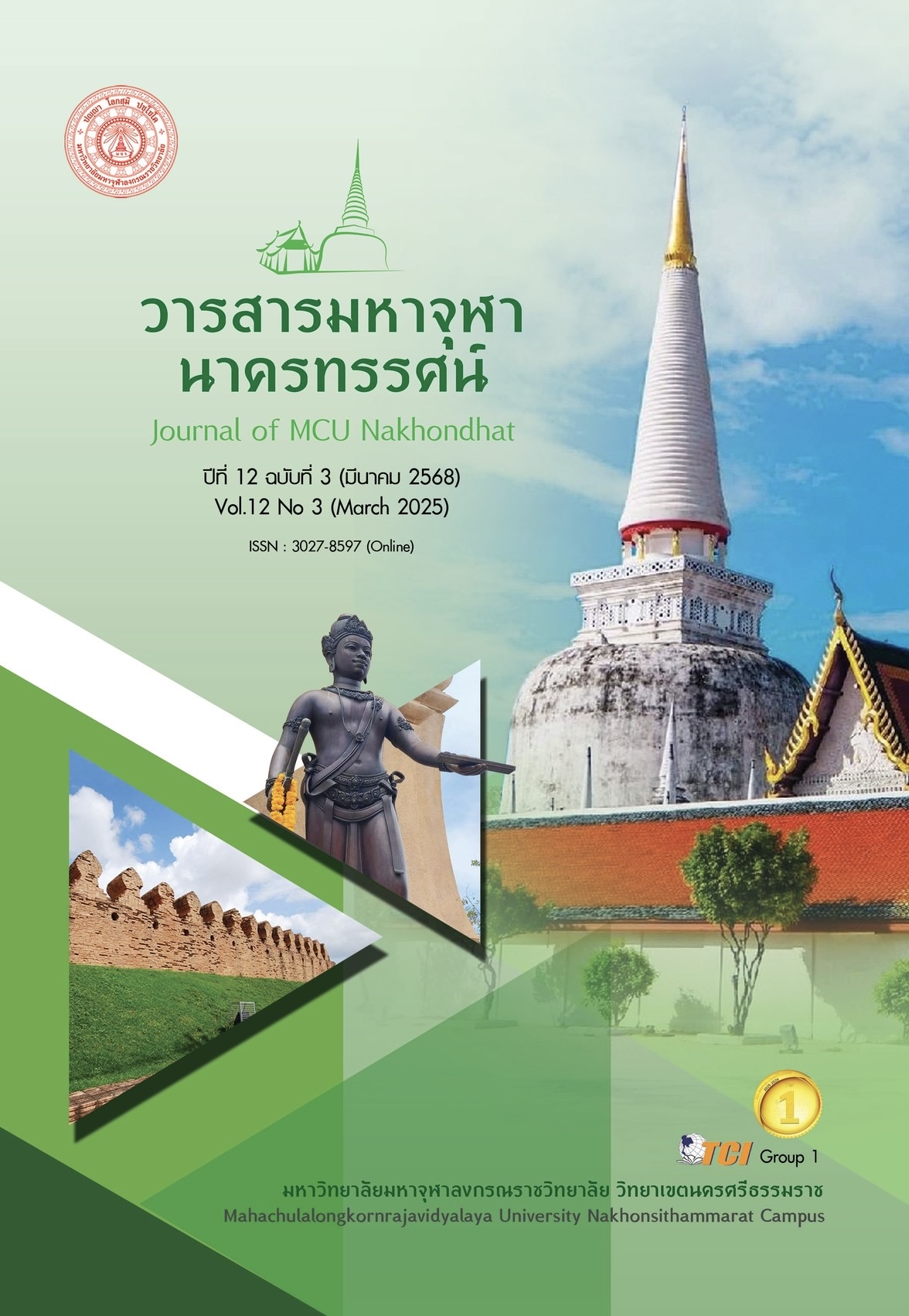THE CULTURAL LANDSCAPE OF SAI BURI, KEDAH, MALAYSIA
Main Article Content
Abstract
This article aims to present the cultural landscape of Sai Buri in Kedah, Malaysia, focusing on the social and cultural history of the Siamese people in Sai Buri, a northern state of Malaysia. Today, Sai Buri is located near Gunung Jerai, also known as the Banyan Mountain. It is referred to by Indians as Mount Meru, a sacred mountain that serves as the dwelling place of Lord Shiva and a landmark for seafarers. In the past, Sai Buri was the fifth city in the zodiac system of Nakhon Si Thammarat under the rule of the Twelve Cities during the 17th-18th Buddhist centuries. The city’s emblem was the Year of the Dragon, which is represented by a large serpent symbol. Siamese and Indian communities were scattered throughout the city, ruled by successive kings. The migration of the Siamese people to Sai Buri was driven by four main factors: Pioneering livelihoods, military conscription and forced relocation, cross-border relations, and escaping legal prosecution. The Siamese in Sai Buri settled in communities, primarily engaging in agriculture while practicing Buddhism and worshiping sacred entities. Monks played a central role in their spiritual and social lives, with temples serving as the focal points for community and cultural activities. Village leaders managed social affairs, maintaining a peaceful and simple way of life. The Siamese people were known for their non-violent nature and used the Southern Thai dialect for communication. Children typically learned the Thai language at temples, where Buddhist monks and Thai volunteers served as teachers. Parents nurtured their children to become virtuous individuals, instilling Thai consciousness, teaching Thai etiquette, and passing on Thai traditions. The Siamese community took great pride in their cultural identity and maintained deep respect and reverence for the King and Queen of Thailand.
Article Details

This work is licensed under a Creative Commons Attribution-NonCommercial-NoDerivatives 4.0 International License.
References
คำนวณ นวลสนอง. (2546). ประวัติศาสตร์ท้องถิ่นของชนเชื้อสายไทยในรัฐเกดะห์ ปะลิสและเประ. กรุงเทพมหานคร: สำนักงานคณะกรรมการวัฒนธรรมแห่งชาติ กระทรวงวัฒนธรรม.
คำนวณ นวลสนอง และคณะ. (2552). พัฒนาการและแนวโน้มการย้ายถิ่นของประชาชนในจังหวัดชายแดนภาคใต้ของไทยเข้าไปในประเทศมาเลเซีย. วารสารมนุษยศาสตร์สังคมศาสตร์ มหาวิทยาลัยทักษิณ, 3(2), 77-97.
จีรวุฒิ (อุไรรัตน์) บุญรัศมี. (2565). ยิ่งกว่าพงศาวดาร “ฮิกายัต” กับความเป็นหลักฐานเชิงลึกของ ความสัมพันธ์สองแผ่นดิน และการนับถือที่ไทรบุรีมีต่อราชวงศ์จักรี. เรียกใช้เมื่อ 15 กุมภาพันธ์ 2568 จาก https://www.luehistory.com/ฮิกายัต-กับความเป็นหลักฐานเชิงลึกของความสัมพันธ์สองแผ่นดิน
ชัยวัฒน์ ปะสุนะ. (2564). รัฐบาลสยามกับการจัดการปกครอง 4 หัวเมืองมลายู (ไทรบุรี ปะลิส กลันตัน และตรังกานู) ระหว่าง ค.ศ. 1873 - 1910. วารสารรัฐศาสตร์และรัฐประศาสนศาสตร์, 12(2), 223-224.
นิติ ภวัครพันธุ์. (2541). บางครั้งเป็นคนไทย บางครั้งไม่ใช่ : อัตลักษณ์แห่งตัวตนที่ผันแปรได้. กรุงเทพมหานคร: สำนักพิมพ์แห่งจุฬาลงกรณ์มหาวิทยาลัย.
นิพนธ์ ทิพย์ศรีนิมิต. (2554). ชาวมาเลเซียเชื้อสายไทยกับการธำรงไว้ซึ่งอัตลักษณ์ทางวัฒนธรรม. วารสารปริชาต, 2(2), 167-169.
ประกายทอง สิริสุข. (2526). การสร้างชาติมาเลเซียและสิงคโปร์. กรุงเทพมหานคร: ไทยวัฒนาพานิช.
ประทุม ชุ่มเพ็งพันธุ์. (2550). พงศาวดารเมืองไทรบุรี. กรุงเทพมหานคร: เดอะโนว์เกจเซ็นเตอร์.
เหมือนขวัญ เรณุมาศ. (2556). ว่าด้วยชาติพันธุ์และเศรษฐกิจการเมืองมาเลเซีย. วารสารรูสมิแล, 34(1), 67-69.
อนุสรณ์ เมฆบุตร. (2549). การบูรณาการกลุ่มชาติพันธุ์ในรัฐพหุสังคม : กรณีศึกษากลุ่มชาติพันธุ์สยามในรัฐเคดาห์ ประเทศมาเลเซีย. ใน วิทยานิพนธ์ศิลปศาสตรมหาบัณฑิต สาขาวิชาภูมิศาสตร์. มหาวิทยาลัยเชียงใหม่.
อมรา พงศาพิชญ์. (2549). ความหลากหลายทางวัฒนธรรม. กรุงเทพมหานคร: สำนักพิมพ์แห่งจุฬาลงกรณ์มหาวิทยาลัย.
อุทัย เอกสะพัง. (2555). บทบาทพระสงฆ์ชาวมาเลเซียเชื้อสายไทในรัฐทางตอนมาเลเซียในเหนือของประเทศมาเลเซีย. ใน รายงานการวิจัย. มหาวิทยาลัยทักษิณ.

